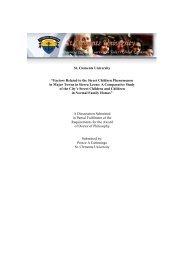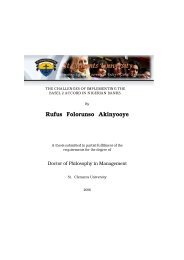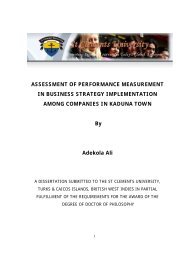The role of informal microfinance institutions in saving
The role of informal microfinance institutions in saving
The role of informal microfinance institutions in saving
Create successful ePaper yourself
Turn your PDF publications into a flip-book with our unique Google optimized e-Paper software.
In construct<strong>in</strong>g the questionnaire <strong>in</strong> terms <strong>of</strong> word<strong>in</strong>g and layout, consideration was given to<br />
its usefulness as a guide for decision or op<strong>in</strong>ion mak<strong>in</strong>g. <strong>The</strong> funnel<strong>in</strong>g approach was adopted<br />
<strong>in</strong> design<strong>in</strong>g the overall structure <strong>of</strong> the questionnaire. This approach <strong>in</strong>volved ask<strong>in</strong>g general<br />
questions first before gradually restructur<strong>in</strong>g the focus through more specific questions, thereby<br />
leav<strong>in</strong>g the most direct question until the last (Stokes, 1998). This technique is used to reduce<br />
elements <strong>of</strong> bias which could come from ask<strong>in</strong>g specific questions up front.<br />
Efforts were made to eschew biased word<strong>in</strong>g <strong>in</strong> the fram<strong>in</strong>g <strong>of</strong> the questionnaire. Cooper<br />
and sch<strong>in</strong>dler (2001) observed that strong adjectives can be particularly distort<strong>in</strong>g <strong>in</strong> the<br />
formation <strong>of</strong> questions. Also attempts were made not to personalize questions. Open-<br />
ended and closed questions were asked bear<strong>in</strong>g <strong>in</strong> m<strong>in</strong>d the different back ground <strong>of</strong> the<br />
respondents such as:<br />
• Respondent motivation: Closed questions have been found to require less motivation<br />
and answer<strong>in</strong>g them is less threaten<strong>in</strong>g to respondents (Cooper and Sch<strong>in</strong>dler, 2001).<br />
Closed questions are preferable <strong>in</strong> large survey as they reduce the variability <strong>of</strong><br />
response, make fewer demands on <strong>in</strong>terviewer skills and much easier to analyze<br />
(Cooper &Sch<strong>in</strong>dler, 2001).<br />
• Communication Skill: Open-ended questions require a stronger grasp <strong>of</strong> vocabulary and<br />
a greater ability to frame responses than do closed questions. Often respondents f<strong>in</strong>d it<br />
difficult to answer open-ended questions. In order to extract the best from respondents,<br />
the follow<strong>in</strong>g response strategies were adopted <strong>in</strong> design<strong>in</strong>g the questionnaire.<br />
• Question Sequence: Arrangement <strong>of</strong> questions play a significant <strong>role</strong> <strong>in</strong> achiev<strong>in</strong>g the<br />
desired response. Consequently, stimulat<strong>in</strong>g questions were asked first before more<br />
sensitive ones. <strong>The</strong> design <strong>of</strong> the questionnaire was therefore structured <strong>in</strong> a manner to<br />
extract the best from the respondents based on the follow<strong>in</strong>g strategies:<br />
• Free response (or open-ended questions)<br />
• Dichotomous response (e.g. Yes or No.)<br />
• Multiple choice response provid<strong>in</strong>g more than two alternatives<br />
156
















